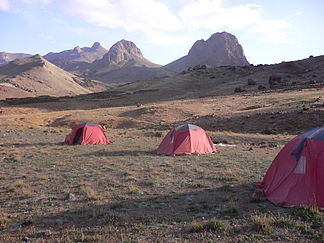Jbel Sirwa
| Jbel Sirwa | ||
|---|---|---|
|
The Jbel Sirwa massif is of volcanic origin |
||
| location | Morocco | |
| part of | Atlas Mountains | |
|
|
||
| Coordinates | 30 ° 42 ′ N , 7 ° 37 ′ W | |
|
Gorge (gorges) of Tislit |
||
The isolated mountain range of Jbel Sirwa or Jebel Siroua ( Arabic جبل سيروا; Central Atlas Tamazight ⴰⴷⵔⴰⵔ ⵏ ⵙⵉⵔⵡⴰ = Adrar n'Sirwa ) in southern Morocco is - despite its geographical proximity to the Toubkal massif in the High Atlas - due to its geological structure and its arid landscape mostly as a part of the Anti-Atlas or - because of its of volcanic origin - viewed as a geologically independent mountain stock.
Location and climate
The mountain, which reaches a maximum height of 3304 m , rises northeast of Taliouine and southwest of Ouarzazate between the places Aoulouz and Askaouen in the east of the province of Taroudannt . The villages of Tizgui , Tagouyamt and Tislit and their surroundings are the main attractions in the center of the mountain range. The sparse rain (approx. 250 mm / year) falls almost without exception in the winter half-year.
population
The area of Jbel Sirwa, which is usually around 700 to 1500 m high, is extremely sparsely populated; there are only a few villages and no cities. The population consists almost exclusively of Berbers , who in the past centuries, perhaps even millennia, have succeeded in wresting what is necessary for survival from the dry and stony soils. Significantly reduced or even absent rainfall since the 1970s has resulted in the migration of many families to the cities of Morocco.
economy
Cattle breeding ( sheep , goats ) is traditionally at the center of agricultural activity . Barley could also be grown on the somewhat more fertile soil in the valley . In contrast, vegetables and fruits, with the exception of onions and beans, as well as pomegranates and prickly pears , had to be bought or bartered in the markets. The main sources of income for the villages in the Jbel Sirwa area are today money transfers from family members, as well as locally sourced saffron and, increasingly, tourism.
Attractions
The agadirs of Tizgui, located in a steep rock face, are among the most impressive buildings of their kind. Some suspect that they were originally residential buildings that were later converted into storage facilities. The bizarre rock formations at Tislit are a reminder that the Jbel Sirwa area is of volcanic origin.


